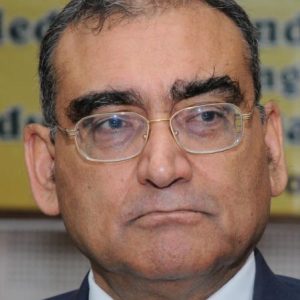
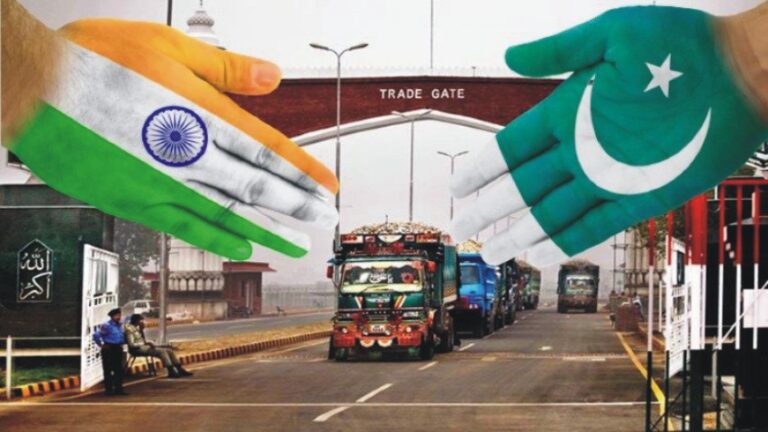
Recently Pakistan Prime Minister Shahbaz Sharif said that Pakistan will seriously examine resuming trade ties with India, and on 23rd March a similar statement was made by the Pakistan Foreign Minister Ishaq Dar
I submit this is just empty rhetoric, and in fact the Pakistan Foreign Ministry spokesperson later said there is no change in the existing position.
Pakistan has said that trade ties can improve if the ‘core issue’ of Kashmir is resolved, while India says that they can improve if Pakistan puts a stop to cross border terrorism.
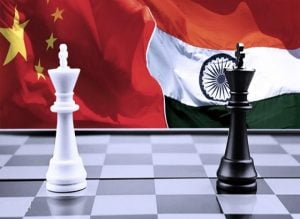 But India and China have trade ties despite their disputes. So trade ties can continue despite animosity. So the statements of both the Indian and Pakistani governments are just pretexts.
But India and China have trade ties despite their disputes. So trade ties can continue despite animosity. So the statements of both the Indian and Pakistani governments are just pretexts.
Presently the small amount of trade between the two countries is not done over the border. The trade is done by sending the goods to Dubai, Singapore, or some other country, and from there to their ultimate destination.
This is clearly irrational, since it adds considerably to the cost, due to duties imposed in the third countries, huge transportation costs, and great waste of time.
There are many goods Pakistan needs which can be supplied by India, and several which India needs which can be supplied by Pakistan. So why are trade restrictions on movement of goods over the border not lifted, and trade allowed with low custom duties?
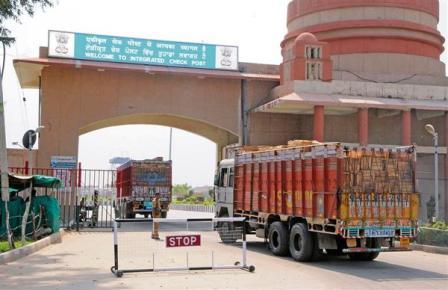 Greater Pakistan-India trade can bring tremendous benefits to Pakistan. Consumers would enjoy lower product prices and more variety. Technology transfers from India would improve Pakistani farm productivity, while lowering manufacturers’ production costs and enhancing their competitiveness internationally.
Greater Pakistan-India trade can bring tremendous benefits to Pakistan. Consumers would enjoy lower product prices and more variety. Technology transfers from India would improve Pakistani farm productivity, while lowering manufacturers’ production costs and enhancing their competitiveness internationally.
Pakistani small manufacturers would increase their efficiency by partnering with larger Indian counterparts, and enjoy advantages of scale thanks to bigger export markets. Also, the Pakistan government would benefit because more legalized trade would generate revenues currently lost to smuggling.
India can also gain immensely from increased trade, according to International Monetary Fund official Arvind Virmani. He identifies two reasons why the Indian business community is particularly supportive.
One is that Indian business leaders already know liberalization works, because domestic economic reforms in the early 1990s—which slashed tariffs and ended decades of protectionism—made the country’s industries stronger.
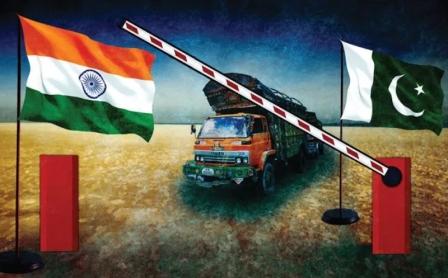
“We expected industry to adapt, adjust, and survive—and it did,” writes Virmani, who has served as a chief economic adviser to the Indian government.
Another reason why Indian businessmen favor more trade is the strong historical memory prevailing in the western Indian states bordering Pakistan. Here, people fondly remember the trade corridors and other economic linkages with present-day Punjab province in Pakistan—links that flourished pre-Partition and persevered until the Pakistan-India war of 1965.
Virmani calls on Indians and Pakistanis to better publicize the positive dimensions of bilateral trade. These include the fact that more trade would eliminate the “deadweight loss” resulting from diverting commerce to third countries.
Despite these obvious advantages, trade between the two countries, and that too only via third countries, is only a trickle of what it should be. Why ?
To answer this question we have to go back in history.
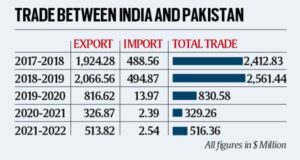 Trade between India and Pakistan declined sharply after the two countries gained independence in 1947. In 1949 India imposed a trade embargo on Pakistan. As a result, Pakistan’s trade with India fell dramatically, from 70 percent in 1947 to 18 percent in 1949.
Trade between India and Pakistan declined sharply after the two countries gained independence in 1947. In 1949 India imposed a trade embargo on Pakistan. As a result, Pakistan’s trade with India fell dramatically, from 70 percent in 1947 to 18 percent in 1949.
From then on, trade between the two countries became almost negligible, mainly due to political differences and the wars of 1965 and 1971.
In 1996, when India granted most favored nation (MFN) status to Pakistan, trade between the two countries was a mere $180 million. That is, it was less than 1 percent of Pakistan’s total trade and only a quarter of a percent of India’s world trade.
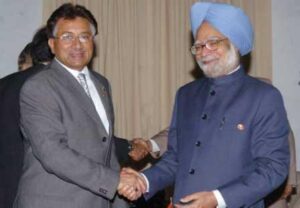
At a meeting in April 2005 between Pervez Musharraf, then Pakistan’s President, and Indian Prime Minister Manmohan Singh in New Delhi a number of trade-related issues were discussed and several key decisions were taken to move the process along in small, though meaningful, steps.
However, most of the decisions were implemented very slowly, if at all, as political tensions, security issues, and domestic political opposition in both countries to any improvement in relations continued to create obstacles.
Nevertheless, trade did pick up significantly following the meeting, reaching $1.5 billion in 2006 and crossing $2 billion in 2008. By 2010, bilateral trade was $2.2 billion, after a dip in 2009 in the wake of the Mumbai terrorist attacks in November 2008, and the total reached $2.5 billion in 2011.
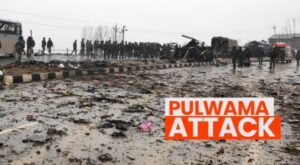 But after the Pulwama attack in 2019 India revoked Pakistan’s MFN (Most Favoured Nation) status, and imposed a 200% import duty on imports from Pakistan.
But after the Pulwama attack in 2019 India revoked Pakistan’s MFN (Most Favoured Nation) status, and imposed a 200% import duty on imports from Pakistan.
On their part, Pakistan suspended trade ties with India when Article 370 of the Indian Constitution was abrogated. However, as said before, trade ties can continue despite disputes, e.g. Indo-Chinese trade ties.
It is submitted that the real reason for not allowing normal trade between the two countries across the border with few restrictions, and with low customs duties, is that there are powerful foreign powers which do not want this, as it may ultimately lead to reunification of India and Pakistan.
India, Pakistan, and Bangladesh were really one country, sharing the same culture, which were one for over 500 years since Mughal times.
If they had remained united the Indian subcontinernt would have emerged today as a modern industrial giant, like another China, which would become a big rival to the developed countries, as explained below :

Partition of India in 1947 and creation of an Islamic state, Pakistan, was a historical British swindle, based on the bogus two nation theory, whose aim was to keep India (which includes Pakistan and Bangladesh) weak and backward. So we have to undo this fraud and reunite.
If trade barriers are removed it will lead to economic unity between India and Pakistan, and economic unity is a precursor to political unity.
The political leaders of both India and Pakistan are really puppets of the developed countries, and the developed countries will oppose our reunification tooth and nail.
So that is why trade ties between the two countries will never normalise until and unless we are reunited.
__________
Also Read:
Hai, Modi kitna bura hai! (Agreed. But…)
Three New Criminal Laws – Some Flaws That Are Prone To Gross Misuse And Abuse
The effect of religious polarisation in India
Congress – Where is it heading?
AI To Help Win Electoral Battles
A great judgment by the Indian Supreme Court
Shilanyas was a mistake, but Rajiv was not aware of unlocking Babri
Assam and West Bengal: BJP’s contradictory stand on CAA in two neighbouring states

Disclaimer : PunjabTodayTV.com and other platforms of the Punjab Today group strive to include views and opinions from across the entire spectrum, but by no means do we agree with everything we publish. Our efforts and editorial choices consistently underscore our authors’ right to the freedom of speech. However, it should be clear to all readers that individual authors are responsible for the information, ideas or opinions in their articles, and very often, these do not reflect the views of PunjabTodayTV.com or other platforms of the group. Punjab Today does not assume any responsibility or liability for the views of authors whose work appears here.
Punjab Today believes in serious, engaging, narrative journalism at a time when mainstream media houses seem to have given up on long-form writing and news television has blurred or altogether erased the lines between news and slapstick entertainment. We at Punjab Today believe that readers such as yourself appreciate cerebral journalism, and would like you to hold us against the best international industry standards. Brickbats are welcome even more than bouquets, though an occasional pat on the back is always encouraging. Good journalism can be a lifeline in these uncertain times worldwide. You can support us in myriad ways. To begin with, by spreading word about us and forwarding this reportage. Stay engaged.
— Team PT


Copyright © Punjab Today TV : All right Reserve 2016 - 2025 |